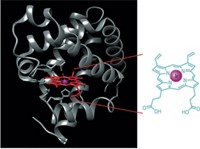Advertisement
Grab your lab coat. Let's get started
Welcome!
Welcome!
Create an account below to get 6 C&EN articles per month, receive newsletters and more - all free.
It seems this is your first time logging in online. Please enter the following information to continue.
As an ACS member you automatically get access to this site. All we need is few more details to create your reading experience.
Not you? Sign in with a different account.
Not you? Sign in with a different account.
ERROR 1
ERROR 1
ERROR 2
ERROR 2
ERROR 2
ERROR 2
ERROR 2
Password and Confirm password must match.
If you have an ACS member number, please enter it here so we can link this account to your membership. (optional)
ERROR 2
ACS values your privacy. By submitting your information, you are gaining access to C&EN and subscribing to our weekly newsletter. We use the information you provide to make your reading experience better, and we will never sell your data to third party members.
Biological Chemistry
Enzymes For Designer Carbs
New screening approach is first to allow glycosyltransferase evolution
by Stu Borman
August 9, 2006
| A version of this story appeared in
Volume 84, Issue 33

In work that could help lead to a new generation of designer sugars, researchers have developed a high-throughput technique for screening mutant forms of glycosyltransferase (GT) enzymes for desired activity, such as greater tolerance for unusual substrates. The technique could aid the creation of modified sugars for drug discovery and a range of other applications.
Scientists have long been interested in designing carbohydrates with new types of sugar building blocks and decorative motifs. But GTs, which transfer sugar "donors" one at a time to specific positions on "acceptor" carbohydrates, are quite fussy about which donors and acceptors they're willing to accept.
To tweak GT substrate specificity, researchers would like to be able to quickly and repeatedly create large libraries of mutant GTs, screen them for activity, select the best prospects, and then modify them again—a lather-rinse-repeat approach called directed evolution. But this hasn't been possible up until now because of the lack of an adequate way to screen GTs for useful activity. The problem is that GT-catalyzed reactions cannot easily be made to cause fluorescence, absorbance, or other changes that can be readily monitored.

Postdoctoral fellow Amir Aharoni and chemistry professor Stephen G. Withers of the University of British Columbia, Vancouver, and colleagues have now found a way around this problem (Nat. Methods 2006, 3, 609). They modify bacteria to express a donor-sugar activating enzyme and mutated GTs, and they feed donor sugar and a fluorescent acceptor sugar to the bacteria. When a variant GT catalyzes donor-sugar transfers to the labeled acceptor, charge or size effects cause the fluorescent reaction product to become trapped in the cell, whereas unreacted fluorescent acceptor can be washed out. The degree of cell fluorescence can be used to assess the level of activity of mutated GTs. Fluorescence-activated cell sorting is then used to select cells containing active GTs for directed evolution.
The technique can be used to screen GTs for activity with either modified donors or variant acceptors. And although the published version of the technique was restricted to charged donors like sialic acid, "since the paper was accepted we have shown that we can also screen galactosyltransferases, which transfer neutral sugars," Withers says.
By screening more than 1 million sialyltransferase variants, the UBC group was able to identify one that catalyzes sialic acid transfer to galactose with 400-fold-higher catalytic activity than the parent enzyme and that can also transfer to a thiosugar acceptor, a new synthetic capability. The thio-linked sialoside so formed "is much more resistant to degradation by sialidases" than conventional sialic acid transfer products, Withers says, "That's one example where this kind of evolution could be valuable."
"Progress in engineering and evolving GTs has long suffered from a lack of high-throughput screens and selections," comments professor Jon S. Thorson of the University of Wisconsin School of Pharmacy, Madison. The method described by Withers and coworkers "is a very clever step toward addressing this extremely difficult problem," he says.
At least two previous GT screening techniques had been developed, but "they didn't allow selection of the large repertoires that one would need to efficiently perform directed evolution," notes professor of biological chemistry Dan S. Tawfik of Weizmann Institute of Science, Rehovot, Israel. The new method, he adds, "is really the first that gives you sufficient screening power" for directed evolution of GTs.




Join the conversation
Contact the reporter
Submit a Letter to the Editor for publication
Engage with us on Twitter